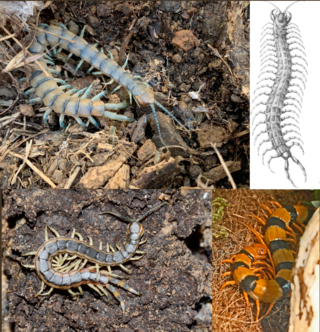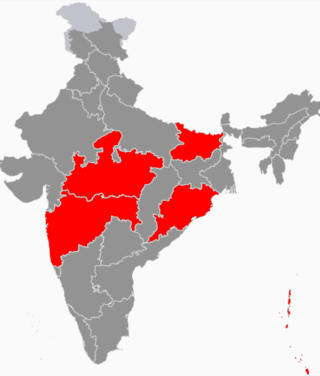
Centipedes are predatory arthropods belonging to the class Chilopoda of the subphylum Myriapoda, an arthropod group which includes millipedes and other multi-legged animals. Centipedes are elongated segmented (metameric) creatures with one pair of legs per body segment. All centipedes are venomous and can inflict painful stings, injecting their venom through pincer-like appendages known as forcipules or toxicognaths, which are actually modified legs instead of fangs. Despite the name, no centipede has exactly 100 pairs of legs; number of legs ranges from 15 pairs to 191 pairs, always an odd number.

Scolopendridae is a family of large centipedes.

Scolopendra is a species-rich genus of large tropical centipedes of the family Scolopendridae.

The Scolopendromorpha, also known as tropical centipedes and bark centipedes, are an order of centipedes whose members are epimorphic and usually possess 21 or 23 trunk segments with the same number of paired legs. The number of leg pairs is fixed at 21 for most species in this order and fixed at 23 for the remaining species, except for two species with intraspecific variation: Scolopendropsis bahiensis, which has 21 or 23 leg pairs, and Scolopendropsis duplicata, which has 39 or 43 leg pairs. Species in this order have antennae with 17 or more segments. The order comprises the five families Cryptopidae, Scolopendridae, Mimopidae, Scolopocryptopidae, and Plutoniumidae. Nearly all species in the family Scolopendridae have four ocelli on each side of the head, and the genus Mimops features a pale area often considered an ocellus on each side of the head, whereas the other three families are blind. Species in the family Scolopocryptopidae have 23 leg-bearing segments, whereas species in all other families in this order have only 21 leg-bearing segments. The only 3 known amphibious centipedes, Scolopendra cataracta, Scolopendra paradoxa and Scolopendra alcyona belong to this order.

The Craterostigmomorpha are the least diverse centipede clade, comprising only two extant species, both in the genus Craterostigmus. Their geographic range is restricted to Tasmania and New Zealand. There is a single ocellus on each side of the head capsule. They have a distinct body plan; their anamorphosis comprises a single stage: in their first moult, they grow from having 12 trunk segments to having 15. Adult centipedes in this order, like those in Scutigeromorpha and Lithobiomorpha, have 15 leg-bearing segments. Their low diversity and intermediate position between the primitive anamorphic centipedes and the derived Epimorpha has led to them being likened to the platypus. They represent the survivors of a once diverse clade. Maternal brooding unites the Craterostigmomorpha with the Epimorpha into the clade Phylactometria which includes Craterostigmomorpha, Scolopendromorpha and Geophilomorpha. This trait is thought to be closely linked with the presence of sternal pores, which secrete sticky or noxious secretions, which mainly serve to repel predators and parasites. The presence of these pores on the Devonian Devonobius which is included in own order Devonobiomorpha permits its inclusion in this clade, allowing its divergence of Lithobiomorpha from Phylactometria to be dated to 375 million years ago.

Scolopocryptopidae is a family of blind centipedes. The number of leg-bearing segments is fixed at 23 for species in this family, which distinguishes the species in this family from all other centipede species.

The Cryptopidae are a family of scolopendromorph centipedes. Cryptopids are blind and possess 21 pairs of legs. The genus Cryptops is the numerically largest in the family, comprising over 150 species worldwide.

Scolopendra hardwickei, the Indian tiger centipede, is a species of centipede in the family Scolopendridae.

Scolopendra cataracta is a species of centipede in the family Scolopendridae. It is the first known amphibious centipede, growing to up to 20 centimetres (7.9 in) in length.

Scolopendra calcarata is a species of centipede in the family Scolopendridae discovered in 1876.

Rhysida longipes, sometimes known as minor blue leg, is a species of centipedes in the family Scolopendridae. Three subspecies are recognized. It is sometimes used as a pet in some countries.

Plutonium zwierleini, in the monotypic genus Plutonium, is one of the largest scolopendromorph centipedes in Europe, and one of the few potentially harmful to humans. Nevertheless, it has been rarely reported, only from the southern part of the Iberian and Italian peninsulas, Sardinia and Sicily.

Hemiscolopendra is a genus of bark centipedes in the family Scolopendridae. There are about six described species in Hemiscolopendra, found in North, Central, and South America.

Scolopocryptops sexspinosus, the eastern red centipede, is a species of centipede in the family Scolopocryptopidae. It is found in North America. It is the only scolopendromorph definitively found in Canada. Canadian specimens appear to be most abundant in British Columbia and Vancouver Island. It is widespread across eastern North America from far southern Canada to the Carolinas and the Gulf Coast, and prefers hiding under rotting wood or leaf litter ; it is thus difficult to find.

Scolopendra galapagoensis, also known as the Galápagos centipede and Darwin's goliath centipede, is species of very large centipede in the family Scolopendridae. It is the only representative of the genus Scolopendra on the Galapagos Islands, among twelve other species of centipede present on the Islands. It is also found on mainland South America in Ecuador and Peru, and on Cocos Island in Costa Rica.

Asanada is a genus of centipedes in the subfamily Scolopendrinae. It has thirteen known species, which usually grow between 25–35 mm (0.98–1.38 in) in length. It can be distinguished from the genus Cormocephalus by having smooth anal pleurae, but is otherwise quite similar in appearance. The type species of the genus is A. brevicornis, the type specimen of which was collected in Kulu, India.

Asanada agharkari is a species of small Scolopendrid centipede in the subfamily Scolopendrinae.
Cormocephalus delta is a species of centipede in the Scolopendridae family. It is endemic to Australia, and was first described in 2019.
Cormocephalus pyropygus is a species of centipede in the Scolopendridae family. It is endemic to Australia, and was first described in 2019.
Cormocephalus sagmus is a species of centipede in the Scolopendridae family. It is endemic to Australia, and was first described in 2019.

















